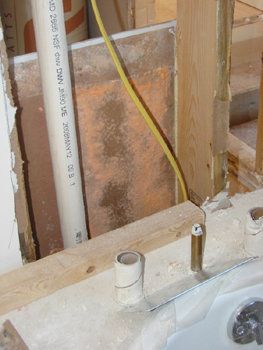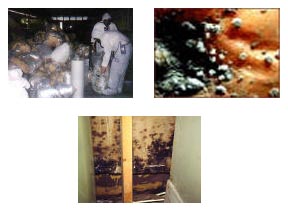| Accredited Environmental Technologies 1-800-969-6AET www.aetinc.biz | ||
|
10 Rental Car Tips: * Don't pay less, pay more, rent from airport vendor. * Take business card from desk and put in your wallet, always take a map. * Decline car if it has greater than 25,000 miles. * Rent a compact: Costs less, saves on gas easier to park and traverse through parking garages. * Existing dings/damages If you rent at night, park under a light to inspect for existing problems. * Overseas: rent/bring GPS (A MUST!). * Check tires: Test each tires wear by using your fingertips between the treads, should be at least 1/4 inch tread life remember (pack a tire gauge), listen for tire noises while traveling * Security: Rent car with trunk, not hatchback. * Decline Gas Option: Ask/note location of nearest gas station for the return fill up and get written directions for return to site. * Wilderness Areas Fill up at ½ tank intervals |
Mold is Ubiquitous Mold can be found almost anywhere; it can grow on any organic substance, as long as moisture and oxygen are present. Molds grow on wood, paper, carpet, foods and insulation. Molds reproduce by making spores that cannot be seen by the human eye. Mold spores enter buildings through outdoor air and/or attach to building occupants. When mold spores land on a damp spot indoors, they can begin growing and digesting whatever they are growing on in order to survive. Mold growth can be controlled indoors by controlling moisture indoors. Decorative Mold Headlines frequently warn about toxic black mold. In Here, Oidium mold is growing on drywall at a new residential structure project. Yes, new construction! Building materials often become wet during construction until the building envelope (i.e. windows, siding and roofing) is complete. Building materials get wet while sitting outdoors waiting for use.
Routine Facility Inspections for Mold/Moisture Awareness expands the number of eyes which can observe a problem and significantly decreases response time to rectify a problem. What to Look For:
AET can provide site-specific training to your staff and develop customized checklists for documentation purposes, upon request. FIRST RESPONDERS: Step #1: Dispose of unwanted porous items. Step #2: Initiate drying of items to remain as soon as possible (within 48 hours to prevent/minimize mold growth) Step #3: Verify the extent of drying by moisture measurement testing (contact AET). Step #4: Perform periodic inspections of impacted building materials by trained building/custodial maintenance staff to evaluate potential mold growth. Step #5: Initiate mold cleanup by trained building custodial/maintenance staff on small projects (usually less than 30 square feet). Make AET Your First Call (610) 891-0114 when a water leak occurs. Take a Proactive Approach to Mold A Mold & Moisture Control Program helps maintain a safe and healthy building environment while controlling the escalating costs of mold and moisture events. This program constitutes a written plan of how moisture events will be approached, assignment of responsibilities, and procedures, which will be implemented. AET's site-specific Mold & Moisture Control Programs include:
BE PREPARED!!!
All molds have the potential to cause health effects. Mold can produce mycotoxins that can trigger allergic reactions or even asthma attacks to people that are allergic to mold. Others are known to produce toxins and/or irritants. Potential health concerns are an important reason to prevent mold growth and the remediation/ cleanup of indoor mold growth. The types and severity of symptoms depend, in part, on the types of mold present and the extent of the individuals exposure, their age, and their existing sensitivities or allergies. The EPA recommends remediation of buildings with mold growth and to correct the water or moisture problems to prevent mold recurrence. EPA recommendations are based on the extent (total surface area) of mold growth; not the type of mold present. The total surface area dictates the recommended use of specific engineering control measures for remediation services. That musty, mildew-like odor associated with mold growth originates from microbial volatile organic compounds (MVOCs) given off by mold during the digestion/metabolism of water impacted building materials (i.e. its food source). The primary MVOCs for mold include acetone, hexane, ethanol and isopropanol, which are released in the ppb range and can be detected by air sampling. Odors can be present without visual confirmation of mold growth on exposed building materials (potential hidden mold). Numerous studies have demonstrated wall cavities are under positive pressure in relation to the adjacent interior occupied space and resulting airflow migrate odors through the wall at openings, electrical switches, etc. Mold is frequently found on the backside of drywall within wall cavities and may not be present on the exposed surface. Wet fiberglass batting within the wall cavity can also cause odors. Inspections for hidden mold should be performed when strong odors persist and no visible exposed mold growth is observed. This inspection involves cutting small sections from the wall to expose the interior wall space (16" to 24" square). Boroscopes can also be used for inspection into the wall cavity, but normally have limited viewing potential. What's That Smell (Wet Fiberglass)? Fiberglass insulation in HVAC systems is frequently can be impacted by moisture (liquid form) due to condensation leaks. Moisture impact can also occur in fiberglass-lined ductwork due to cold temperature & condensation. Inherently, musty odor complaints can occur. This odor can typically be detected by cutting a small section of wet fiberglass and noting its smell. This odor is usually not associated with mold, but rather bacteria. Fiberglass itself is not a good nutrient source for mold growth (mold will grow on dirt/debris associated with the fiberglass). The odor originates from bacteria contamination (primarily gram negative bacteria) as a result of chronic or significant acute moisture impact. BEST ADVICE: Remove wet/saturated fiberglass, omit internal insulation immediately downstream of the cooling coil. This problem also is prevalent with fiberglass batting in leaking roofs and inside wall cavities. New ANSI/ASHRAE Standard: AET IAQ investigations continue to identify limited or inadequate HVAC maintenance, deferred repairs and non-sanctioned modifications as the principal causes leading to occupant complaints. These conditions lead to variations in thermal comfort, equipment failure, reduced energy efficiency and poor indoor air quality in commercial buildings. Where maintenance is neglected, energy costs can rise significantly and equipment life drastically reduced. Recently, ANSI/ASHRAE published the first consensus standard to address inspection and maintenance of HVAC systems (ANSI/ASHRAE Standard 180-2008, "Standard Practice for Inspection and Maintenance of Commercial Building HVAC System"). AET recommends to all of our clients the incorporation of this standard and its practices. Facility managers, building engineers, and maintenance personnel should be knowledgeable of the document and trained in it's practices. Copies of this standard are available through ASHARE, you can get a copy of this standard by calling 1-800-527-4723 (cost $31.00) or visit About Our Organization Accredited Environmental Technologies, Inc. (AET) is a Commonwealth of Pennsylvania corporation founded in 1984 as a professional consulting firm and analytical laboratory to provide cost effective solutions to complex environmental problems. AET is recognized as a national environmental firm providing services from coast to coast. AET's corporate headquarters is located in Media, Pennsylvania, just outside Philadelphia. Environmental services are conducted under the direct supervision of professional Industrial Hygienists certified by the American Board of Industrial Hygiene to ensure proper documentation, chain of custody and admissibility in potential litigation activities. Project Managers are assigned to each project based on the client's environmental needs and concerns. AET's Project Managers are experienced and trained to provide solid professional advice. AET has a proven record of success in the environmental industry. AET's corporate ownership, including corporate officers, have remained unchanged after 20 years of service providing long term stability in an ever changing world. Over 80% of AET's Office Personnel have been with our corporation over 7 years.
|
|




 fact, mold can develop into growths of many decorative colors such as pink, purple and orange. The color of the mold depends on what building materials the mold is digesting as its food source. The toxicity of the mold is irrelevant to its color; the same mold can manifest itself into many different colors.
fact, mold can develop into growths of many decorative colors such as pink, purple and orange. The color of the mold depends on what building materials the mold is digesting as its food source. The toxicity of the mold is irrelevant to its color; the same mold can manifest itself into many different colors. A proactive approach to mold can save you both time and money while protecting the health and safety and continued productivity of your work force.
A proactive approach to mold can save you both time and money while protecting the health and safety and continued productivity of your work force.



